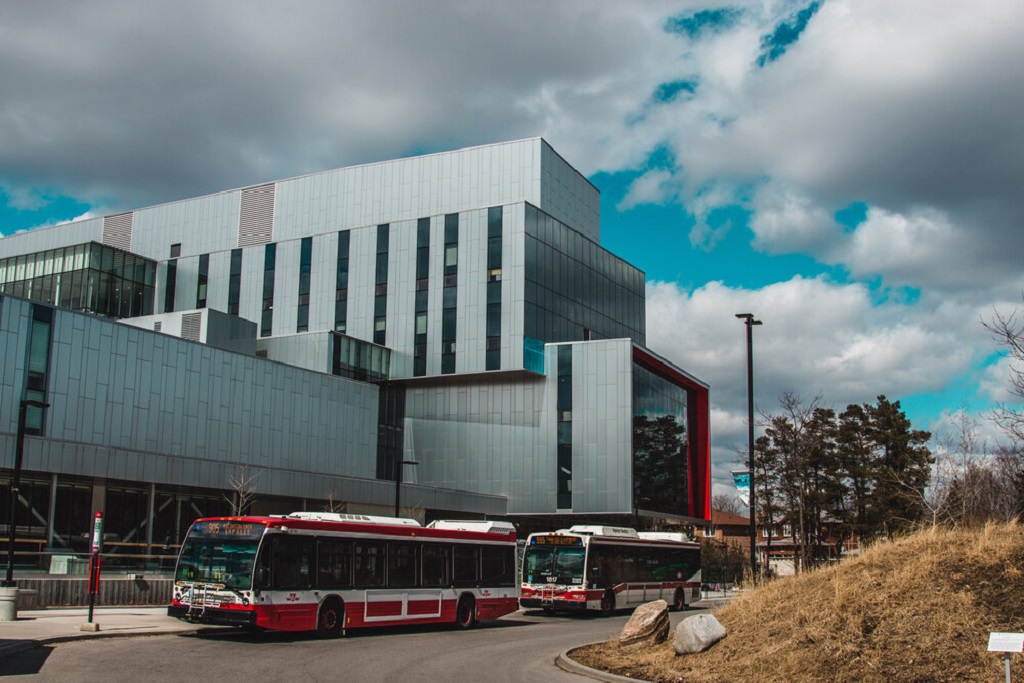
#FordNation? More like #AbomiNation
What do the OSAP cuts mean for UTSC students?
Signing up for sugar daddies and receiving generous donations from pop-singers are just two of the ways that Ontario students are getting creative to scrape up enough money for their post-secondary education. Which, thanks to Premier Doug Ford, is becoming increasingly inaccessible. Despite the backlash and a multitude of student protests, the provincial representatives seemingly ignore the fact that cutting funding to education cuts into Ontario’s future. Students are dropping out of their programs until they’ve earned enough to afford paying their tuition fees. Many of them attend the University of Toronto Scarborough (UTSC).
Karen Ruano, a second-year Anthropology and Human Geography student, is taking a semester off to save money so she can come back later and finish her second degree.
“I’m not even coming back to school in September because of them,” Ruano said. “It’s just sad because I actually like going to school, and I would like to finish my degree, but it’s just not gonna happen.”
Last year, while also working full-time and getting OSAP, she was able to cover some of her tuition and a quarter of her books.
“I was able to cover my tuition for the first semester,” Ruano said. “I was lucky, my professors had their own material that they handed out instead of doing books.”
Ruano is one of many UTSC students who face a tough decision: to continue education and graduate sooner, or put education on hold to save some money and finish education then. Ruano’s friend graduated a year ago, and instead of finding a job in her field, she works at Starbucks.
“You have to take a semester off to save a bit and take the hit afterward and see what happens,” Ruano said. “For someone who has already graduated from the program and gone to work already, it’s not that easy.”
Post-secondary education in Ontario is higher than any other province in Canada: the average Ontario university tuition is close to $9,000, while the average 2018-19 college tuition is $3,400. When Ford announced a 10 per cent reduction in tuition fees in January, many students were skeptical about it, and rightfully so. The cut would save Ontario students roughly $440 million, but the announcement also included a $670-million-dollar cut from the Ontario Student Assistance Program (OSAP).
Cutting funding from OSAP – the main source of education money for students – creates barriers to education overall. In many individual cases, the government has substantially reduced the amount of grants and increased the amount of loans, which means students have to pay back more.
Kimberley Chow, a fourth-year English student at UTSC, said that she gets fewer grants and more loans than in previous years.
“My grants would be $6,000, my loans would be like, $2,000. And recently, it’s literally switched, the numbers have switched,” she said.
The government said they slashed this grace period to “reduce complexity for students”, but what they’ve done is added an unnecessary loan burden. The increased amount of loans leads to higher student debt.
“Is there a way to make up for it?” Reanne Chen, a fourth-year English student, said. “I’m a little bit over $20,000 in debt, and my grants are also getting less than last year.”
But that’s not all. Along with OSAP and tuition cuts, the government has eliminated the 6-month grace period to pay the OSAP loans back without interest. This grace period allowed students to find a job to help pay off their debt without interest on their loan for the first six months following graduation. Now students will have to pay interest as soon as they receive their diploma, regardless of whether or not they have a job lined up.
Chow’s friend was supposed to have graduated in 2019, but now he does not have time to pay his loans without interest. He is one of many students who are trying to find ways to save as much money as possible.
“(My friend) decided to take another year of school to sort of, like, spread out the time frame that he has to pay the loans back,” Chow said. “He’s trying to find a job at the same time.”
The provincial government wants to convince the students that there are upsides to the OSAP changes: “a tuition reduction means that money stays in the pockets of Ontario’s students and their families,” said the official statement from the Ministry of Training, Colleges and Universities. With increasing real estate costs, the hike in grocery prices and even TTC fares, it’s hard to say that students will save money if their tuition is cut. A 10 per cent reduction is not worth the future if students have to decide whether to survive now to pay for rent and tuition, or to complete their degree and hope it will help them survive in the long run.
It’s important to recognize that OSAP cuts impact more than a student’s tuition. Rebekkah Nighswander from the Department of Student Life said that OSAP amounts also affect a student’s housing, food security and transit. Since student clubs and organizations are not directly affected by the OSAP cuts, but rather by the Student Choice Initiative, Nighswander said that the true impact would be seen after September 19, the deadline to opt-out of selected services on campus, which include student clubs.
“Student Choice Initiative” is a governmental tactic to push universities to let students opt-out of some non-tuition fees via an online opt-out option. The government evidently leads the students to believe that they have a choice in what fees they can pay. However, the Canadian Union of Public Employees (CUPE), an organization that represents academic contract workers at the University of Toronto, warns the students against opting out.
“We expect that many students will opt out of the fees because of their own increased financial burden thanks to those cuts to the OSAP program,” said the Union in a statement on June 19. “And those who don’t opt-out will be rewarded with a campus whose services and organizations are forced to operate on a shoestring budget.”
The number of fees and whether or not students can opt-out varies widely among institutions and can add up to $2,000 yearly. Usually, these fees include funding for student organizations, services and specialized equipment. Over time, however, they have been introduced to cover a range of campus activities, including athletic facilities, on-campus health clinics, wireless internet, counseling, and student activities and even student ID cards.
University of Toronto Scarborough (UTSC) students can find their opt-out fees on ACORN -> Financial Account -> Incidental Fees. Opting out in the author’s case adds up to $887.99, with $170.33 being the highest mandatory fee for UTSC Sports & Recreation Complex. In a university of 13,630 students in 2018, choosing to opt-out of all incidental fees would mean $12 million for UTSC to make up for. Fees for health programs, athletics and some other services will remain mandatory.
Scarborough Campus Students’ Union (SCSU) has different programs that support students from low-income families. Because of the cuts, they can’t support those people anymore as much as they want to, especially those who need help.
“In a year, where our members need more support from services like the Food Centre or our Free Book Network, we are being asked to do more with less,” said Chemi Lhamo, president of the SCSU, in an email. “Our operating budget now faces a cut of up to 40 per cent.”
Aaheli Mukherjee, chair and president of TEDxUTSC, said that now clubs are focused on being more financially responsible and conservative with budget spending as the amount of clubs funding is never a 100 percent guarantee.
“The cuts have happened so recently in terms of budget planning that we don’t really know the actual effects of it yet,” Mukherjee said in an email. “A lot of the true effects are yet to unfold.”
There are speculations that students in clubs and student groups may soon have to pay extra for attending clubs and student groups. But that is yet to come.
International students don’t have to worry about being unable to afford education because of OSAP cuts since they are expected to fund their education, and they’re generally not eligible for funding options.
“It’s only really if students become permanent residents in Canada, that they’re eligible for OSAP, and then they will be eligible for the anxiety that comes along with this year,” said Erika Loney, manager at UTSC’s International Student Centre.
Loney does not think that the university will increase tuition for international students in an attempt to make up for funding deficits. The increases that the university makes to international student tuition is different than for domestic student tuition, and are set through the governing council every year, usually during February or March. She added that the university doesn’t increase students’ tuition by much for already registered students.
“This is really the year where you’d probably see (any increases because of the cuts),” Loney said. Generally, she said, there is a consistent increase in tuition fees.
International full-time students have the option of working 20 hours off-campus on a study permit and work full-time during academic breaks if they wish to help fund their education. There is no outside body regulating the number of hours they work, but if the students are not keeping with the conditions of their study permit, they have to explain that when they’re applying for other statuses, like permanent resident or a visitors permit.
UTSC’s First Year Programs Coordinator in the Department of Student Life Rebekkah Nighswander said that tuition changes came so swiftly that the university had little time to respond appropriately.
“Luckily, the university has a lot of support, like UTAPS, already in place,” Nighswander said. UTAPS is the University of Toronto Advance Planning for Students, a tool to help students prepare to finance their education. “But, I imagine there will be a lot of changes in the future to address provincial funding cuts, which have affected both OSAP amounts and the funding universities receive from the government.”
UTSC provides options for those students that don’t receive enough funding, like UTAPs, which helps to fill some funding gaps.
“You must be a full-time student and must be receiving OSAP (if you are an Ontario resident),” Nighswander said. “Students receiving financial aid from other Canadian provinces or territories, or from a First Nations Band, may also be eligible for UTAPS.”
She also suggests looking into bursaries and scholarships as they often go unused. But the most important thing for UTSC students to understand is that students can appeal their OSAP amounts.
“You can appeal online,” Nighswander said, “but also make sure to visit the Financial Aid Advisors at the Registrar’s Office to learn more about appealing your OSAP, and applying for financial aid, bursaries and scholarships. While there’s no guarantee that your appeal will be granted, it’s always worth it to try.”
She said to make sure to connect with friends and campus resources about student discounts or other funding options.
“Did you know the TTC and GO Bus offer student discounts?” she said in an email. “Did you know the City of Toronto has a Rent Bank program to help individuals who can’t afford their rent? Did you know the SCSU runs a food bank? Did you know the university has a Work-Study program to help students obtain on-campus jobs? There are a lot of resources to help!”
Unfortunately, some students have had to give up their internships at jobs in the fields they’re studying to pursue better-paying jobs.
“I work for a small business that lost three interns over the summer because the OSAP cuts forced them to get another job (not in their field but paid better). Students are losing out on valuable experience. #thanksford #ontarioclosedforbusiness,” said one student in a tweet.
It is reasonable to worry that these reductions will set students back, and they will have to drop out to be able to pay for future education. It’s a choice between surviving now and surviving later.
The Progressive Conservative government maintains its cuts to OSAP were necessary to “address the previous government’s unsustainable spending”. Merrilee Fullerton, Ontario’s minister of training, colleges and universities, said that the government is putting students first.
“Students matter and how they receive their education in an affordable and effective way is very important,” Fullerton said during the announcement in January. “Our government cares very much about making post-secondary education affordable and accessible.”
All that the students hear upon statements like this is “bullshit”.
“I don’t think that the government realizes that it’s not that easy,” Karen Ruano said. “Sure, their kids can enter internships through their connections and everything.”
These funding changes put the future of Ontario into question. OSAP is an investment in Ontario, and judging by his actions towards education, Premier Doug Ford does not know how to invest. Ford’s motto “Ontario – open for business” will not hold up if its students aren’t educated enough to make and keep Ontario open for business.
President of the Scarborough Campus Students’ Union Chemi Lhamo stressed that the government needs to prioritize grants over loans and not drag future graduates further into debt. She said that SCSU would continue to advocate for publicly funded higher education and to reducing the upfront cost of tuition for all students, including international, she added.
“We need a government that is more committed to the accessibility of a quality post-secondary education system than a buck-a-beer,” Lhamo said. “Rather than purporting to be here ‘for the students’ or ‘for the people’, this government needs to actually hear what we have been saying.”
If you’re affected by the changes, please consider reaching out to various financial services available at UTSC.
Kate Bandura for The Underground
You May Also Like

Raise Hell at Toronto’s Hottest Halloween Parties 2017
October 18, 2017
Conquering Chills on Halloween Night
October 20, 2017



